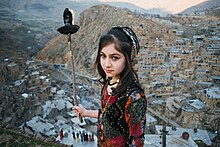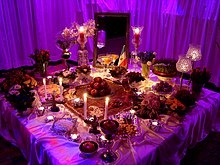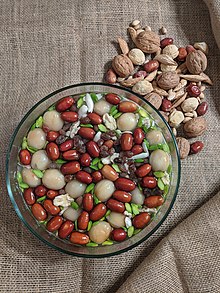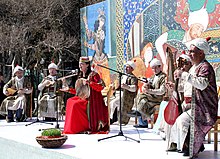Nouruz
Nouruz ( Persian نوروز, DMG Naurūz , Kurdish نهورۆز Newroz , in Turkish Nevruz ; translated “New Day”) is the name of the Persian New Year and Spring Festival , which is celebrated with the day of the astronomically calculated entry of the sun into the zodiac sign of Aries, the beginning of spring (equinox), especially in the Iranian cultural area . The day falls on March 20 or 21 and begins at different times according to the beginning of the equinox.
Since May 10, 2010, Nouruz has been recognized as an international Nouruz day by resolution of the 64th General Assembly of the United Nations . In its declaration, the General Assembly stated that "Nouruz is a spring festival that has been celebrated by more than 300 million people for more than 3000 years in the Balkan Peninsula , the Black Sea region , the Caucasus , Central Asia and the Middle East ". On September 30, 2009, UNESCO added Nouruz Day to the list of Masterpieces of the Oral and Intangible Heritage of Humanity .
etymology

Literally translated, Nouruz means 'New Day' (nou or nau: new , Ruz: day ). The wordsروز Ruz ,رۆچ Roç orرۆژ Roj in Iranian languages , whichstandfor day , go back to the Ur-Indo-Iranian Rauça (pronounced "Rautscha"), which in turncomesfrom the Ur-Indo-European * Leuk- , from which the word light in German originated. In Iranian languages there was a sound shift from “l” to “r” and from / k / to / č /.
In Old Iranian Avestan was Raôçah actually for light use, newly called Nava . The old Persian form was Rauçah . In Old Indo-Aryan was Roçiş (pronounced Rotschisch ) in use.
The current term Nou-Roz was first mentioned in the 2nd century.
history
Until the 1st century BC In the Iranian highlands, the summer solstice marked the turn of the year, which was celebrated with great harvest festivals . Under the Achaemenids (around 770 to 300 BC) the vernal equinox became the official start of the year. For the Iranian peoples in Iran , Tajikistan and Afghanistan , this point in time is calculated by astronomers to the hour and minute. On this day the Kharaj tax was levied. The tradition of the New Year celebrations has survived to this day and has spread to East Africa .
The Persian poet Firdausi (around 940 to 1020/1026) recorded one of the most famous versions of the origins of the New Year in his Shāhnāme (“Book of Kings”). Firdausi sets the New Year festival Nouruz in the reign of Jamschid . Jamjid was the fourth king of the Kayanid family . He commanded all beasts, demons and angels . He was king and at the same time the highest priest of Ormozd (Middle Persian for Ahura Mazda ). Firdausi writes about Jamshid:
“There sat like the shining sun in the air,
The Shah, who does not revoke any command.
They stood strewn with jewels, they
called the day New Year's Day.
The beginning of the year, the hormone of Ferwedin
, when the joy of the world appeared.
...
From those days such a happy day
remained for us from that prince. "
For the Parsees in India this day is therefore still called Jamschēd-i Nawrōz . In Persia, the day was the most important secular holiday over the centuries , but it was also a public holiday in the Kurdish provinces of the Ottoman Empire . It was celebrated as a big folk festival where equestrian games were held and people gathered in squares and in the streets, lit fires and splashed each other with water. At the time of the Achaemenids , the population of Nouruz was no longer subject to tax for a certain time. But the day was also important for completely different reasons. Because at Nouruz representatives of the conquered peoples came to Persia and brought gifts to the Persian king.
After the Islamization of Persia, Nouruz was celebrated on different days. Initially, Nouruz was on June 18. The caliph al-Mutawakkil moved the day to June 17th and al-Mu'tadid to June 11th. During a calendar reform under the Seljuq ruler Malik Shah I , Nouruz was set on March 15 in 1079. Today Nouruz is celebrated on March 20th or 21st.
In Iran and among the Kurds , its character as a ritual of passage has been preserved to this day. In preparation for the new phase of life, new clothes are put on and, as a sign of the end of winter, campfires are lit, over which people jump and around which especially the boys dance and sing. The women prepare a celebratory meal and relatives and friends go to a park or an excursion site together. Sometimes a band is hired, mostly the musicians move from one meeting to the next and play traditional, political or love songs depending on their taste .
With the spread of nationalist ideas in the 20th century, the festival took on greater political significance among the Kurds . They celebrate the New Year on March 21st as a symbol of the successful resistance to oppression handed down in Iranian mythology . At the center of this performance are the legends of the tyrant Zohak (Dahak, Dahaq), who is presented as a child-eating dragon king, and his conqueror, the blacksmith Kaveh . Together with the population, Kaveh went out and killed Zohak. Out of joy, the people started a fire that spread the news across the country. According to tradition, this happened on March 21, 612 BC. BC. Historically, this year corresponds to the victory of the Medes over the Assyrians at Nineveh . The legend of the myth of origin is expanded in a form that is also common .
The Nouruz festival also has a political and nationalistic significance in Iran, where the population has consistently resisted attempts by the Islamic clergy to relativize the importance of this festival, which dates back to pre-Islamic Iranian history, whose rituals, e.g. B. to forbid the Tschahar Schanb-e Suri (“Wednesday fire”) or to combine this with mourning ceremonies, for example by visiting the cemeteries on the first Nouruz day.
In the Baha'i calendar Nowruz (Naw-Ruz) is one of nine public holidays, it marks the beginning of the new year and the end of the nineteen-day fasting period of Bahai .
Since the last century, Nouruz has spread widely across Iran, Turkey, Iraq, Syria, and Central Asia. Also today people celebrate Nouruz in Russia and the Balkans . Each country has its own specific spelling and pronunciation of the term “Nouruz”.
Customs and Ceremonies
Detention sin
Nouruz takes place at the beginning of spring , on March 20 or 21 ( Nawe Cal نوى کالor Sperli - "New Year" or "Spring" in the Pashto language , Sâle No. سال نو- "New Year" in Persian ). The most important part of the New Year is the preparation of haft-seen ( "Seven S", the components must necessarily start with the first letter of the Persian "S", which are: Sekke - coins; Sib - apple; Somach - a Persian spice ( Gewürzsumach ); Sombol - the hyacinths ; Sir - garlic; Sabseh - wheat, barley, cress or the like; and Serke - vinegar), and the seven-fruit New Year's drink Haft Mewa . Seven dishes are prepared, which should begin with the letter "S" if possible and symbolize the seven virtues of Zoroastrianism , and together with samanak (seedlings from seven types of grain), a mirror, a candle and a holy or important book (the Koran in Muslims , the Bible for Christians , the Avesta or a picture of Zarathustra for Zoroastrians or a book of poems) on a table.
Amu Nouruz, Naneh Sarma and Hajji Firuz

For the New Year festivities, Amu Nouruz's journey and gifts are also known, who is accompanied by a dancing, joking and music- making Hajji Firuz and, according to tradition, only comes to Nouruz once a year near his beloved wife, Naneh Sarma , from whom he is otherwise separated all year round. He finds her sleeping and moves away again, so that she has to wait another year for his return.
Tschahar Schanbe Suri
On the eve of the last Wednesday before Nouruz, the Tschahar Schanbe Suri (“Wednesday fire”) is lit. This old Iranian (Zoroastrian) custom is one of the most important rituals of the Persian New Year festival. The evening before, children and young people in disguise sometimes go from house to house, hitting pots and lids and receiving sweets or other small gifts from the residents.
distribution

The celebration of the festival can be traced back to the Zoroastrian ancestors of today's Iranian peoples. Nouruz is an official holiday in Northern Iraq ( Autonomous Region Kurdistan ), in Iran , Azerbaijan , Afghanistan , Kazakhstan , Kyrgyzstan , partly and unofficially in Pakistan , Syria , Tajikistan , Turkmenistan , in Turkey , in Uzbekistan (two days), Georgia ( one day) and India with the Parsees as a Jamschidi festival (see also Holi ). Nouruz is also celebrated by the remaining Ottoman-Turkish population groups in south-eastern Europe ( Balkans ) such as Albania (where it is the only country in Europe that is a public holiday and is mainly celebrated by the Bektaschi community), Bosnia and Herzegovina , Bulgaria , Greece , Moldova , North Macedonia and Romania . Nouruz is very important to all Kurdish and Balochian tribes and other Iranian peoples not mentioned here .
Before the calendar correction by the astronomer Omar Chayyām in 1079, the Spring Festival was celebrated for about 40 days between late February and late March. Since the Islamization of the area at the mausoleum , named after the cousin and son-in-law of the Prophet Mohammed ʿAlī ibn Abī Tālib , in the northern Afghan city of Mazār-i Sharif in the province of Balkh (formerly Baktra), the festival has been known for forty days under the title Melâe Gole Sorx ( Melā-ye gol-e sorch , " Tulip Festival ") celebrated. A Zoroastrian temple is said to have been located there. The city is a secret capital of the Nowruz Festival. The festival and its ceremonies were also celebrated there during the Taliban's rule .
The meaning of the Nouruz in Bahaitum
The Bahaitum takes up the Nouruz festival and expands its importance. In the Baha'i calendar Nowruz (Naw-Ruz) is one of nine public holidays, it marks the beginning of the new year and the end of the nineteen-day fasting period of Bahai . The New Year celebration is set on the day of the spring equinox and the start of spring in the northern hemisphere. For the Baha'i, Nouruz is no longer just a national festival for Iranians, Kurds and Afghans, but a religious festival with a deep spiritual meaning: Due to the new beginning of the annual cycle in nature and the end of the dark season, Nouruz symbolizes spiritual renewal. The fact that Nouruz falls on the day of the spring equinox is a symbol of the manifestations of God (such as Jesus , Buddha , Moses ), which unite divine and human nature.
Bahāʾullāh writes about the Nouruz day : “This day is truly the crown of all months and their origin, the day when the breath of life blows over all created things. Great is the blessing of one who greets him with cheerfulness and joy. We testify that he is really one of those who achieved their goal. "
With the spread of Baha'i, this originally ethnic Indo-Iranian festival has globalized. It is celebrated by all Baha'i worldwide.
Nouruz in the Turkic states
Although Nevruz is believed to be a Persian custom, it also appeared in the Twelve Turkish Animal Months and was known to the Turkic peoples as early as the 8th century BC. Known and celebrated by them. The main view of Nevruz is that it is a celebration of independence. In other words, that it marks the day of Ergenekon's departure . Therefore, Nevruz was accepted by the Turks as the beginning of the new year and is still celebrated with festivals. Among the Turkish communities of Central Asia, the Azeris, Kazakhs, Chirgis, Turkmen, Uzbeks, Uighurs, the Anatolian Turks and the Balkan Turks have kept the Nevruz tradition alive to this day.
Azerbaijan
In Azerbaijan, the Nevruz festival is very important. Although the Russians banned the festival during the Soviet rule, most Azerbaijani Turks continued to celebrate the festival. Novruz holiday is one of the most important and popular holidays of the Azerbaijani people. It marks the arrival of spring, the renewal of nature, and is celebrated on the spring equinox on March 20-21 - the start of the astronomical new year. The origin of Novruz goes back to old customs, nature and fertility cults as well as the belief in the decline and rise of nature. In the month before Novruz, the four elements of nature are celebrated one after the other every Wednesday: water, fire, earth and air (or wind). The last element, Axır Çərşənbə, stands for the time when the leaves bloom and spring finally begins. Symbols include Samani. The cultivation of Samani (green sprouting wheat) is the most sacred Novruz ceremony as a harbinger of spring. The Samani seedling symbolizes sowing and a rich harvest. It stands for grain, bread, multiplication and abundance. Grain and abundance is a pledge for life, existence, the most important material necessity for life. People have always grown samani from wheat, barley, peas, lentils or other types of grain in copper dishes; they have always admired it and enjoyed its germination. In the evening, children tuck hats under the neighbors' doors and hide to wait for the neighbors to fill the hats with holiday gifts. After sunset, people gather in the streets to light bonfires, dance around them, and jump over them to purify their souls and ward off evil spirits. One of the most important parts of the banquet table is xonça - a tray filled with sweets, nuts, candles and painted eggs. Each of the sweets baked for Novruz has a symbolic meaning. Baklava represents the four parts of the world, Qoğal the sun, Şəkərbura the moon and the painted eggs are a symbol of life. Samani adorns the middle of the tray and is tied with a red ribbon.
The main celebrations during the Novruz festival usually take place on the walls of the legendary Virgin Tower. The top of the tower is adorned with a huge samani, next to it is the torch installed on the tower, the flame of which symbolizes the awakening of nature and life.
Kazakhstan
The Kazakhs recite Mevlid prayers during Nevruz ceremonies. The houses are cleaned in the spring and people wear their best clothes. During the Nevruz celebrations, people throw mud cups against walls or furniture to break them and jump over the fire. It is well known that jumping over fire is a symbol of leaving behind the misfortune and illness of the past year and making a healthy start to the new year. The Kazakhs prepare a special meal called Nevruzköcö during Nevruz . They also prepare another meal called lapa , a soft rice, and pass it on to their neighbors that day.
Kyrgyzstan
The Kyrgyz call the first day of the New Year Nooruz and on this day they prepare and eat a special meal called Nooruz köcö . This is a moist syrup made from corn or crushed wheat. Auz köcö , also known as kavut , is another special meal that is prepared for the day. Sheep are also traditionally sacrificed. On the eve of the festival, the house and yard must be put in order. The children born during this period are called Nouruzbek or Nouruzbai (boys) and Nouruzdjan or Nouruzgül (girls). There is another special tradition at Nouruz: Burning the juniper, also called Artscha, and the Kyrgyz national sport, Kök-Börü .
Turkey
In Turkey, the Nevruz festival was banned for years. Although the ban was enforced in the larger cities, the population in the more rural areas continued to celebrate Nevruz. In 1991 and 1992, the situation came to a head, 125 people died when the Turkish security forces tried to enforce the ban. With the change in government in 2000, the ban was lifted. Today the government even sponsors the festival; Among other things, support funds can be applied for to hold the festivities. The state television broadcaster TRT Avaz also organizes festivals on March 21st in Turkey, but also in other Turkish-speaking countries, and broadcasts a special program throughout the day.
Traditionally, the preparations, i.e. cleaning the house and preparing the dishes, begin the day before, March 20th. People get up early on March 21st. They go to the cemetery in fresh clothes and, depending on the region, with coffee. After they return, they must wash with water and then drink water. This is said to purify the soul. Afterwards we eat together. Pastries with spinach, eggs colored with onion skins, thin pastries, fried chickpeas, Burma baklava and sweets like Turkish honey are among the dishes and dishes served on Nevruz Day. While eating, people play musical instruments and sing folk songs. Rocking and flying kites, known as the Bayrak (flag), as well as jumping over fire are intended for entertainment.
Turkmenistan
The Turkmen call the first day of the new year Novruz. Five or six days before Novruz, families start cleaning their houses. Turkish pastries such as Petir , Külce , Börek , Koko , Bovursak and rice are prepared. It is believed that preparing many different foods will bring good luck for the next year. Semeni is the special food that is made during Nevroz. Many families come together and prepare food in a large cauldron by adding flour and sugar to the wheat. Semeni is cooked the day before meal and prepared for the morning of March 21st.
Uzbekistan
In preparation for the holiday, people clean up their homes and mahallas (neighborhoods) and buy new clothes. Before, during and after Navruz, it is customary to prepare sumalak, the main ceremonial dish of the holiday. Sumalak is a sweet paste made entirely from sprouted wheat and cooked in a large Kazan. To prepare sumalak, friends, relatives and neighbors - usually women - gather around the Kazan, all of whom take turns stirring the mixture. When the sumalak is ready, it is distributed among neighbors, relatives and friends. In Navruz people also visit relatives and friends and give presents to the children.
Prohibition of Nouruz
In addition to Turkey, the Nouruz festival was also banned in Syria for years.
Calendar meaning
The new year begins with Nouruz in Iran and Afghanistan. The counting of the new year is based on the solar calendar in Iran as a country of the Indo-Iranian cultural area . It begins with the equinox of spring between March 19 and 21 and therefore together with the astrological zodiac sign Aries . Alongside the Mehrgan autumn festival, the New Year is one of the oldest traditional festivals in the Central Asian region and the Indian subcontinent .
The Islamic New Year is not the same as the Nouruz Festival, as it is calculated according to the Islamic lunar calendar with only 355 days. It is always celebrated in the 12th Islamic lunar month after the great Hajj pilgrimage ( Id al-Adha , "Kurban Festival" or " Festival of Sacrifice ") as the end of the Islamic lunar year. It shifts backwards every year by 10 or 11 days within the solar year, so that 34 lunar years correspond to 33 solar years.
See also
literature
- Naw-Rúz: New Day, A Compilation . Kalimát Press, Los Angeles 1992, ISBN 0-933770-84-7 .
- Article NOWRUZ of the Encyclopædia Iranica , online edition, 2016, with the sections:
- Wilhelm Eilers : The old name of the Persian New Year (= treatises of the Academy of Sciences and Literature. Humanities and social science class. Born in 1953, Volume 2). Verlag der Wissenschaft und der Literatur in Mainz (commissioned by Franz Steiner Verlag, Wiesbaden). Mainz 1953.
Web links
- Norus - an international festival . Islamic Republic of Iran Broadcasting (IRIB), March 20, 2010
- Link with customs and dishes for the Nouruz festival
- Mir H. Sadri: For Nauroz (New Year) (Tulip Festival) in Afghanistan . Mazar-i-Sharif.de, April 2, 2003
- Javad Parsay: The Iranian New Year Celebration Nowruz . Association of Iranian Engineers in Austria, 2005
- Norouz Research Foundation. (No longer available online.) Archived from the original on September 15, 2008 ; accessed on March 18, 2018 (English).
- Nau-Roz Mobarak . Afghan-Aid, February 11, 2005
- Fikrat Safar: Newroz and its importance for Kurds. (No longer available online.) NAVEND - Center for Kurdish Studies e. V., archived from the original on February 12, 2013 ; accessed on March 18, 2018 .
Individual evidence
- ^ Kurdistan: The New Year Festival Newroz. Retrieved March 21, 2020 .
- ↑ Nevruz Bayramı nedir? Nevruz Bayramı neden ve niçin kutlanır? - İşte cevabı. Retrieved March 23, 2019 (Turkish).
- ^ International Nowruz Day
- ↑ http://www.un.org/News/Press/docs/2010/ga10916.doc.htm
- ↑ Friedrich Rückert : Firdosi's King Book (Schahname) Sage I-XIII. 1890. Reprint: epubli GmbH, Berlin, 2010, p. 20. ISBN 978-3-86931-356-6
- ↑ a b New Year Festival Nouruz - The victory of light over darkness . In: Swiss Radio and Television (SRF) . March 27, 2018 ( srf.ch [accessed August 29, 2018]).
- ↑ Fattaneh Haj Seyed Javadi: The morning of drunkenness. Insel, Frankfurt am Main 2000, p. 414
- ↑ Baha'u'llah: Kitab-i-Aqdas . The holiest book. Bahá'í-Verlag, Hofheim 2000, ISBN 3-87037-379-2 (online). Paragraph 111
- ↑ Nevruz. Retrieved March 22, 2020 .
- ↑ Abdullah Şengül: Türk Kültüründe Nevruz Nevruz ve Anadoluda kutlamaları. Retrieved March 22, 2020 (Turkish).
- ↑ Prof. Dr. Erman Artun-TÜRK DÜNYASINDA NEVRUZ. Retrieved March 22, 2020 .
- ↑ Baharın Müjdecisi Nevruz Bayramı ... Accessed March 22, 2020 .
- ↑ Azerbaijan celebrates Novruz Holiday - News | Ministry of Culture of the Republic of Azerbaijan. March 19, 2019, accessed March 22, 2020 .
- ^ Nevruz Celebrations in Turkey and in Central Asia. Retrieved March 22, 2020 .
- ↑ Nouruz - the second New Year celebration. In: Novastan German. January 1, 2018, accessed on March 22, 2020 (German).
- ↑ a b Declared war on the Kurds . In: Der Spiegel . tape March 14 , 1992 ( spiegel.de [accessed August 29, 2018]).
- ^ Peaceful Newroz Festival in Southeast Anatolia | NZZ . In: Neue Zürcher Zeitung . March 21, 2001, ISSN 0376-6829 ( nzz.ch [accessed August 29, 2018]).
- ^ Nevruz Celebrations in Turkey and in Central Asia. Retrieved April 27, 2019 .
- ↑ Onedio.com: Geçmişten Günümüze Türk Kültüründe 21 Mart Nevruz Bayramı. Retrieved April 27, 2019 (Turkish).
- ↑ Nevruz Bayramı nedir? Nasıl kutlanır? Retrieved April 27, 2019 (Turkish).
- ^ Nevruz Celebrations in Turkey and in Central Asia. Retrieved March 22, 2020 .
- ^ Zulfiya Tursunova: Women's Lives and Livelihoods in Post-Soviet Uzbekistan: Ceremonies of Empowerment and Peacebuilding . London 2014, p. 26-27 .
- ↑ Muhamad Abdi: Kurds celebrate Newroz New Year . In: Der Tagesspiegel Online . March 16, 2018, ISSN 1865-2263 ( tagesspiegel.de [accessed August 29, 2018]).






